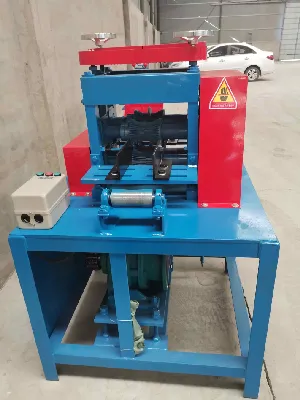

Jun . 15, 2024 09:51 Back to list
 Non-ferrous metals, such as aluminum, copper, and brass, require more sophisticated methods Non-ferrous metals, such as aluminum, copper, and brass, require more sophisticated methods
Non-ferrous metals, such as aluminum, copper, and brass, require more sophisticated methods Non-ferrous metals, such as aluminum, copper, and brass, require more sophisticated methods how metals are sorted in recycling plants. Here, eddy current separators come into play. These machines use a rapidly rotating magnetic field to propel non-ferrous metals forward, separating them from other materials.
For even more precise sorting, particularly for smaller particles, sensors and optical sorters are employed. These high-tech systems use near-infrared (NIR) or X-ray transmission (XRT) technology to identify and sort metals based on their chemical composition. NIR sensors detect the unique reflection patterns of different metals, while XRT can penetrate the metal to determine its density.
The sorted metals are then compacted into bales, making them easier to transport and reducing storage space. These bales are sent to smelters where they are melted down and transformed into new, raw materials for manufacturing.
In conclusion, the sorting of metals in recycling plants is a complex and multi-faceted process that combines human labor with cutting-edge technology. It's a testament to our ability to harness science and innovation for sustainable practices. By effectively sorting and recycling metals, we not only conserve natural resources but also reduce greenhouse gas emissions and minimize environmental impact. As technology continues to evolve, we can expect even more efficient and accurate methods in the future.
how metals are sorted in recycling plants. Here, eddy current separators come into play. These machines use a rapidly rotating magnetic field to propel non-ferrous metals forward, separating them from other materials.
For even more precise sorting, particularly for smaller particles, sensors and optical sorters are employed. These high-tech systems use near-infrared (NIR) or X-ray transmission (XRT) technology to identify and sort metals based on their chemical composition. NIR sensors detect the unique reflection patterns of different metals, while XRT can penetrate the metal to determine its density.
The sorted metals are then compacted into bales, making them easier to transport and reducing storage space. These bales are sent to smelters where they are melted down and transformed into new, raw materials for manufacturing.
In conclusion, the sorting of metals in recycling plants is a complex and multi-faceted process that combines human labor with cutting-edge technology. It's a testament to our ability to harness science and innovation for sustainable practices. By effectively sorting and recycling metals, we not only conserve natural resources but also reduce greenhouse gas emissions and minimize environmental impact. As technology continues to evolve, we can expect even more efficient and accurate methods in the future. Latest news
The Future of Metal Recycling: Revolutionizing Waste Management
NewsMay.14,2025
Optimizing Waste with Recycling Lines
NewsMay.14,2025
Municipal Solid Waste Sorting Line: Revolutionizing Waste Management
NewsMay.14,2025
Metal Shredders: Essential Tools for Efficient Recycling
NewsMay.14,2025
Maximize Your Profits with a Copper Wire Granulator
NewsMay.14,2025
Home Metal Shredder: A Smart Choice for Your Home Recycling Needs
NewsMay.14,2025